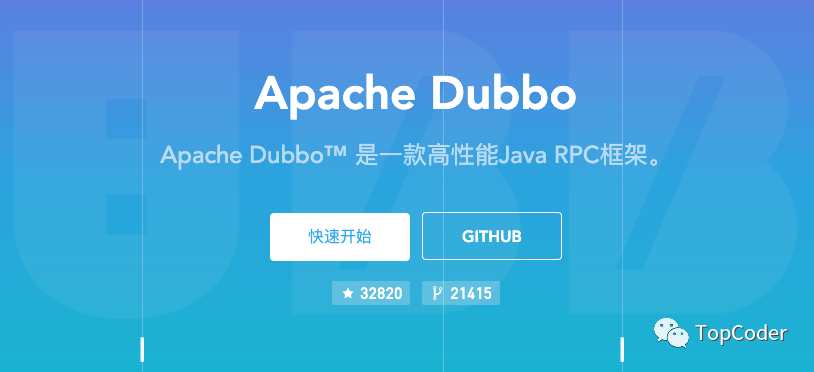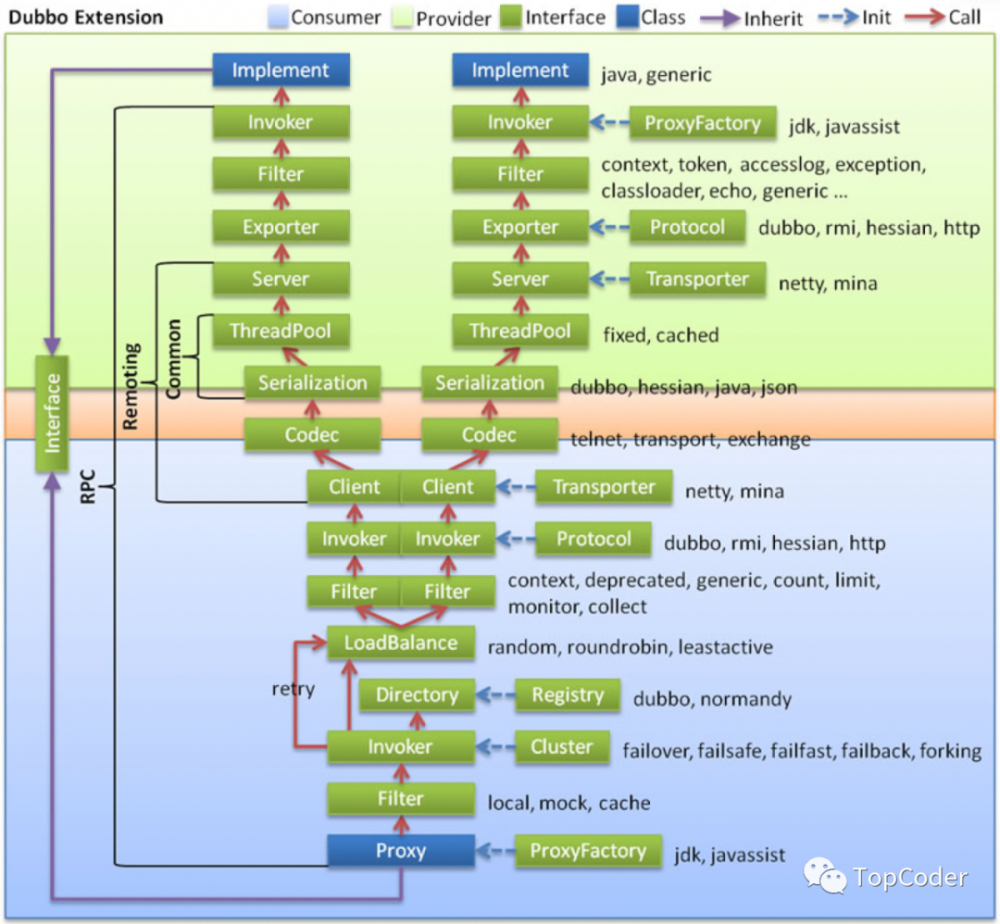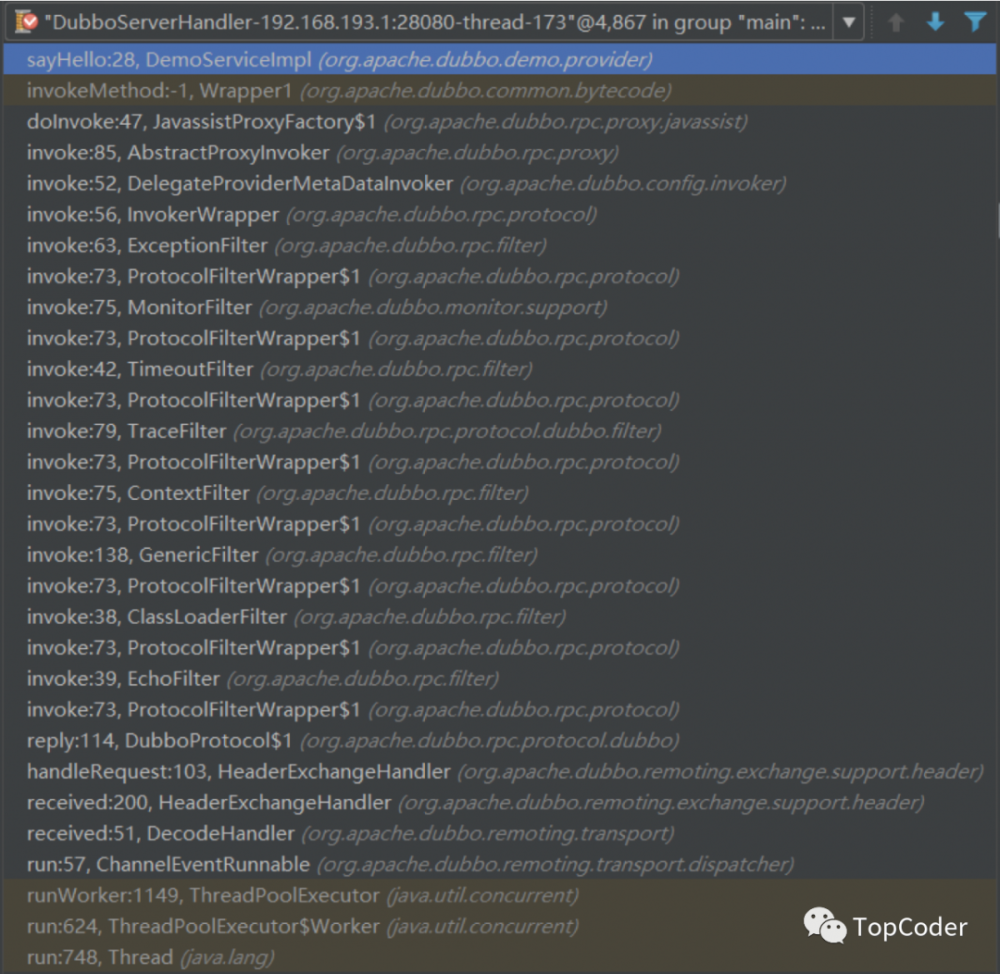Dubbo RPC在Provider端是如何跑起来的
戳蓝字「TopCoder 」关注我们哦!

dubbo RCP请求到达provider后,首先经过数据接收、解码(NettyWokerThread/NioEventLoop),然后传递到RPC后续流程(DubboServerHandler),即filter、service invoke过程,service invoke过程也就是执行真正服务的逻辑,执行完毕后再经过编码作为响应返回给RPC调用者。
在分析之前,首先来看一下整体的RPC流程:

处理流程
NettyServerHandler 是dubbo在netty设置的 ChannelHandler , NettyServerHandler 的处理逻辑是将请求message提交给 DubboServerHandler 线程池。
// MultiMessageHandler
public void received(Channel channel, Object message) throws RemotingException {
if (message instanceof MultiMessage) {
MultiMessage list = (MultiMessage) message;
for (Object obj : list) {
handler.received(channel, obj);
}
} else {
handler.received(channel, message);
}
}
// AllChannelHandler
public void received(Channel channel, Object message) throws RemotingException {
// 提交给DubboServerHandler线程池
ExecutorService cexecutor = getExecutorService();
cexecutor.execute(new ChannelEventRunnable(channel, handler, ChannelState.RECEIVED, message));
}
ChannelEventRunnable 事件的处理逻辑是 org.apache.dubbo.remoting.transport.dispatcher.ChannelEventRunnable#run ,事件类型包括连接、断开、发送、异常等:
public enum ChannelState {
CONNECTED,
DISCONNECTED,
SENT,
RECEIVED,
CAUGHT
}
RPC执行
下面是调用HelloServiceImpl的一个调用栈信息:

Filter执行
进入DubboServerHandler线程池的流程首先就是dubbo中各个filter, EchoFilter、ClassLoaderFilter、ContextFilter、TraceFilter、TimeoutFilter、MonitorFilter 。
// EchoFilter
public Result invoke(Invoker<?> invoker, Invocation inv) throws RpcException {
if (inv.getMethodName().equals(Constants.$ECHO) && inv.getArguments() != null && inv.getArguments().length == 1) {
// 是否是echo
return new RpcResult(inv.getArguments()[0]);
}
return invoker.invoke(inv);
}
// ClassLoaderFilter
public Result invoke(Invoker<?> invoker, Invocation invocation) throws RpcException {
ClassLoader ocl = Thread.currentThread().getContextClassLoader();
Thread.currentThread().setContextClassLoader(invoker.getInterface().getClassLoader());
try {
return invoker.invoke(invocation);
} finally {
Thread.currentThread().setContextClassLoader(ocl);
}
}
// GenericFilter
public Result invoke(Invoker<?> invoker, Invocation inv) throws RpcException {
return invoker.invoke(inv);
}
// ContextFilter
public Result invoke(Invoker<?> invoker, Invocation invocation) throws RpcException {
Map<String, String> attachments = invocation.getAttachments();
RpcContext.getContext()
.setInvoker(invoker)
.setInvocation(invocation)
.setLocalAddress(invoker.getUrl().getHost(),
invoker.getUrl().getPort());
// merged from dubbox
// we may already added some attachments into RpcContext before this filter (e.g. in rest protocol)
if (attachments != null) {
if (RpcContext.getContext().getAttachments() != null) {
RpcContext.getContext().getAttachments().putAll(attachments);
} else {
RpcContext.getContext().setAttachments(attachments);
}
}
if (invocation instanceof RpcInvocation) {
((RpcInvocation) invocation).setInvoker(invoker);
}
try {
return invoker.invoke(invocation);
} finally {
// IMPORTANT! For async scenario, we must remove context from current thread, so we always create a new RpcContext for the next invoke for the same thread.
RpcContext.removeContext();
RpcContext.removeServerContext();
}
}
Filter的包装类如下所示,它会将各个filter依次串起来:
new Invoker<T>() {
@Override
public Class<T> getInterface() {
return invoker.getInterface();
}
@Override
public URL getUrl() {
return invoker.getUrl();
}
@Override
public boolean isAvailable() {
return invoker.isAvailable();
}
@Override
public Result invoke(Invocation invocation) throws RpcException {
// 调用各个filter,filter组成了一个filter链,最后一个会调用服务的方法
return filter.invoke(next, invocation);
}
@Override
public void destroy() {
invoker.destroy();
}
@Override
public String toString() {
return invoker.toString();
}
};
RPC反射调用
RPC反射调用流程:
// AbstractProxyInvoker
public Result invoke(Invocation invocation) throws RpcException {
try {
Object value = doInvoke(proxy, invocation.getMethodName(), invocation.getParameterTypes(), invocation.getArguments());
CompletableFuture<Object> future = wrapWithFuture(value, invocation);
CompletableFuture<AppResponse> appResponseFuture = future.handle((obj, t) -> {
AppResponse result = new AppResponse();
if (t != null) {
if (t instanceof CompletionException) {
result.setException(t.getCause());
} else {
result.setException(t);
}
} else {
result.setValue(obj);
}
return result;
});
return new AsyncRpcResult(appResponseFuture, invocation);
} catch (InvocationTargetException e) {
} catch (Throwable e) {
}
}
// JavassistProxyFactory
public <T> Invoker<T> getInvoker(T proxy, Class<T> type, URL url) {
// TODO Wrapper cannot handle this scenario correctly: the classname contains '$'
final Wrapper wrapper = Wrapper.getWrapper(proxy.getClass().getName().indexOf('$') < 0 ? proxy.getClass() : type);
return new AbstractProxyInvoker<T>(proxy, type, url) {
@Override
protected Object doInvoke(T proxy, String methodName,
Class<?>[] parameterTypes,
Object[] arguments) throws Throwable {
return wrapper.invokeMethod(proxy, methodName, parameterTypes, arguments);
}
};
}
// provider服务类
public class DemoServiceImpl implements DemoService {
@Override
public String sayHello(String name) {
System.out.println("[" + new SimpleDateFormat("HH:mm:ss").format(new Date()) + "] Hello " + name + ", request from consumer: " + RpcContext.getContext().getRemoteAddress());
return "Hello " + name + ", response from provider: " + RpcContext.getContext().getLocalAddress();
}
}
通过反射执行,就到达了业务处理逻辑,获取到返回结果之后,会组装 AppResponse 结果返回给客户端。
Filter链初始化
Filter链的初始化是在初始化线程模型之前就已完成的:
public NettyServer(URL url, ChannelHandler handler) throws RemotingException {
super(ExecutorUtil.setThreadName(url, SERVER_THREAD_POOL_NAME), ChannelHandlers.wrap(handler, url));
}
// ChannelHandlers
public static ChannelHandler wrap(ChannelHandler handler, URL url) {
return ChannelHandlers.getInstance().wrapInternal(handler, url);
}
protected ChannelHandler wrapInternal(ChannelHandler handler, URL url) {
return new MultiMessageHandler(new HeartbeatHandler(ExtensionLoader.getExtensionLoader(Dispatcher.class)
.getAdaptiveExtension().dispatch(handler, url)));
}
从上述代码来看,handler已经在初始化NettyServer时构建完成了,继续往上跟,代码如下:
public RemotingServer bind(URL url, ChannelHandler listener) throws RemotingException {
return new NettyServer(url, listener);
}
public ExchangeServer bind(URL url, ExchangeHandler handler) throws RemotingException {
// DecodeHandler -> HeaderExchangeHandler -> 责任链handler
return new HeaderExchangeServer(Transporters.bind(url, new DecodeHandler(new HeaderExchangeHandler(handler))));
}
// DubboProtocol
private ProtocolServer createServer(URL url) {
url = URLBuilder.from(url)
// send readonly event when server closes, it's enabled by default
.addParameterIfAbsent(CHANNEL_READONLYEVENT_SENT_KEY, Boolean.TRUE.toString())
// enable heartbeat by default
.addParameterIfAbsent(HEARTBEAT_KEY, String.valueOf(DEFAULT_HEARTBEAT))
.addParameter(CODEC_KEY, DubboCodec.NAME)
.build();
String str = url.getParameter(SERVER_KEY, DEFAULT_REMOTING_SERVER);
ExchangeServer server = Exchangers.bind(url, requestHandler);
return new DubboProtocolServer(server);
}
requestHandler对应的是org.apache.dubbo.rpc.protocol.dubbo.DubboProtocol#requestHandler,其实现了ChannelHandler接口(可处理各种事件),针对请求来说,对应代码如下:
public CompletableFuture<Object> reply(ExchangeChannel channel, Object message) throws RemotingException {
Invocation inv = (Invocation) message;
// 获取invocation对应的处理链
Invoker<?> invoker = getInvoker(channel, inv);
RpcContext.getContext().setRemoteAddress(channel.getRemoteAddress());
Result result = invoker.invoke(inv);
return result.thenApply(Function.identity());
}
Invoker<?> getInvoker(Channel channel, Invocation inv) throws RemotingException {
boolean isStubServiceInvoke = false;
int port = channel.getLocalAddress().getPort();
String path = inv.getAttachments().get(PATH_KEY);
// 根据服务dubbo key(name+version等)获取对应的处理链
String serviceKey = serviceKey(port, path, inv.getAttachments().get(VERSION_KEY), inv.getAttachments().get(GROUP_KEY));
DubboExporter<?> exporter = (DubboExporter<?>) exporterMap.get(serviceKey);
return exporter.getInvoker();
}
也就是说,处理链的获取是从provider端服务列表-处理链 仓库中获取的,该仓库是在dubbo provider启动流程中初始化的,关于这块不是本文的分析重点,因此不再赘述。
- 本文标签: final 线程池 ssl map id App build constant https API REST ACE apache cat IO CTO consumer Service heartbeat IDE Proxy list http java NIO 线程 CEO provider Transport remote 数据 equals value entity executor tar 代码 dubbo message tab UI 模型 key src ORM Netty
- 版权声明: 本文为互联网转载文章,出处已在文章中说明(部分除外)。如果侵权,请联系本站长删除,谢谢。
- 本文海报: 生成海报一 生成海报二











![[HBLOG]公众号](https://www.liuhaihua.cn/img/qrcode_gzh.jpg)

